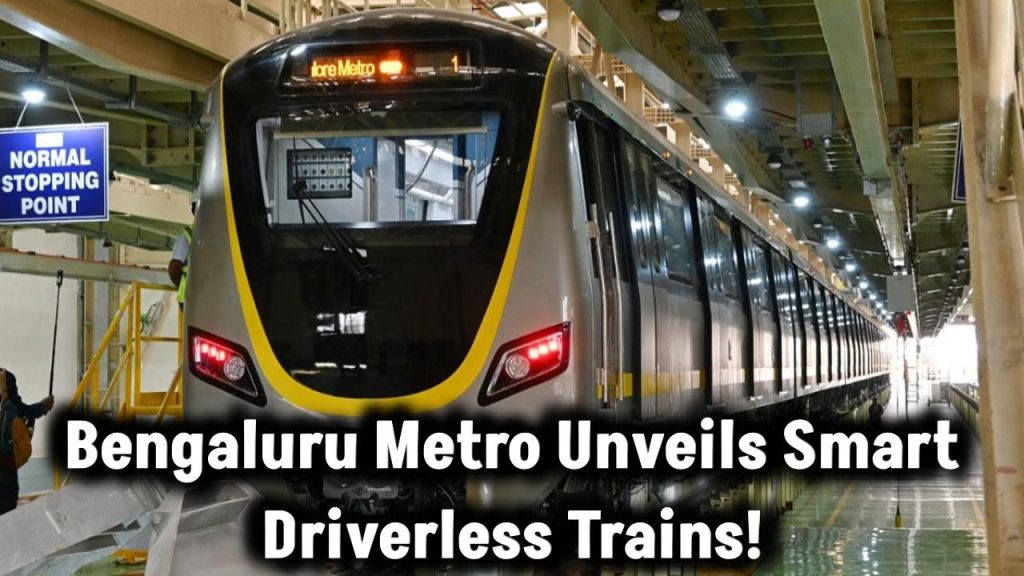
Bengaluru Metro has taken a significant leap into the future with the launch of smart driverless trains, bringing advanced automation and cutting-edge technology to urban transportation. This revolutionary move is set to enhance safety, efficiency, and passenger experience, making Bengaluru’s metro system one of the most technologically advanced in India.
Also Check: Govt Holiday Calendar 2025 OUT! Check School, College, Bank & Office Holidays NOW!
What Makes Bengaluru Metro’s Driverless Trains Special?
1. Fully Automated Operations
Bengaluru Metro’s new driverless trains operate on the highest level of automation, GoA4, meaning they require no onboard staff. These trains can start, stop, and regulate speed automatically, ensuring optimal performance at all times.
2. Smart AI-Powered Safety Systems
Passenger safety is a top priority, and these smart metro trains are equipped with AI-driven monitoring that detects obstacles, monitors track conditions, and prevents collisions in real time. Additionally, an automatic emergency braking system ensures a safe journey.
3. Energy-Efficient Design
The driverless metro trains utilize regenerative braking technology, which converts braking energy into electricity, significantly reducing power consumption. This eco-friendly approach will help lower Bengaluru Metro’s carbon footprint.
4. Increased Frequency & Reduced Waiting Time
With full automation, metro trains will operate at higher frequency, reducing waiting times for passengers. This ensures that commuters can travel seamlessly without long delays.
5. Better Passenger Experience
- Spacious interiors with modern seating and standing arrangements
- LCD screens displaying real-time updates
- Enhanced air conditioning for improved comfort
- Automatic doors with obstruction sensors
Why Bengaluru Metro Needed Smart Driverless Trains
Bengaluru is India’s IT capital, home to millions of daily commuters. The introduction of driverless trains will address increasing congestion, reduce human errors in operations, and improve urban mobility.
With traffic congestion ranking among the worst globally, a high-tech metro system is crucial to improving commuter convenience and environmental sustainability.
Also Check: RBI Rule: how much money will be returned if the bank collapses, think carefully before depositing
How Driverless Trains Compare to Conventional Metros
| Feature | Driverless Metro | Conventional Metro |
| Automation Level | Fully automated (GoA4) | Partially automated |
| Operational Efficiency | Higher efficiency, better punctuality | Human-dependent operations |
| Energy Efficiency | Uses regenerative braking | Standard braking |
| Passenger Safety | AI-powered collision prevention | Manual intervention required |
| Staff Requirement | No onboard drivers | Requires train operators |
Where Will These Trains Run?
The first deployment will be on the Yellow Line, which connects R.V. Road to Bommasandra (18 km), covering major IT hubs like Electronics City. Future plans include expanding driverless technology to other metro lines.
Benefits for Commuters
🔹 Reduced Delays & Faster Travel
High-frequency trains mean less waiting time and faster commuting.
🔹 Enhanced Safety Measures
With AI-driven monitoring, the chances of human errors and accidents reduce drastically.
🔹 Comfortable & Modern Infrastructure
Upgraded interiors, better ventilation, and digital displays improve commuter experience.
🔹 Lower Carbon Footprint
Eco-friendly operation with regenerative braking technology reduces energy consumption.
Challenges & Potential Concerns
1. High Initial Costs
Building a fully automated metro system requires a significant investment in technology and infrastructure.
2. Need for Skilled Workforce
While onboard staff is reduced, maintenance teams must be trained in AI, automation, and cybersecurity to ensure smooth operation.
3. Cybersecurity Risks
Since the metro system relies on digital communication and AI, it must be protected against cyber threats and hacking attempts.
4. Public Adaptation
Some commuters might feel uneasy about traveling without a human driver, requiring awareness campaigns to educate the public on safety measures.
Also Check: AIC Recruitment 2025 Notification PDF Out for 55 Management Trainees Vacancies
Bengaluru Metro Driverless Trains (FAQs)
1. When will Bengaluru Metro’s driverless trains start operating?
The first driverless metro is expected to start operations by 2025 on the Yellow Line.
2. Are these trains safe?
Yes, the trains use AI-powered safety features, including real-time monitoring and emergency braking, making them safer than conventional metros.
3. Will there be staff on board in case of an emergency?
Initially, there may be metro staff for assistance, but once fully operational, the system will be completely driverless with remote monitoring from a central control room.
4. Which areas will the driverless metro serve?
The first rollout is on the Yellow Line (R.V. Road to Bommasandra, 18 km). Future expansions will include other metro corridors.









